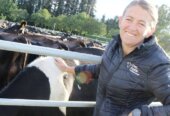Far from being the stuff of nightmares, the leeches being bred in the Waikato on New Zealand’s only leech farm are highly valued medical miracles. Viv Posselt investigates.
Medical leeches / Public Domain
Maria and Robert Lupton have been breeding leeches for about 34 years.
They started out in Northland, then moved to Aranga where they managed a farm for four years before purchasing a farm at Matiere in the King Country in 2000. After selling that in 2007, they moved to their current Te Miro farm, housing their precious leeches in an adapted cowshed.
Millions of the parasitic worms have gone from their care to serving a critical purpose in hospitals around the country (and further afield) where they have become mainstream in aiding wound healing in the aftermath of surgery.
2024 has been a particularly busy one … it’s tracking to be a record year in terms of demand for the little suckers.
The perfectly-designed blood feeders have been used medicinally for thousands of years. In today’s hospitals, they help prevent a post-operative condition called venous congestion, which occurs when the blood pools and stagnates in veins cut during surgery. As the leeches feed on areas of damaged tissue, they reduce the risk of blood clotting, thereby allowing time for new, healthy tissue to grow. Each tiny bite comes with a shot of naturally occurring anaesthetic that helps numb the area.

Maria Lupton giving some of the leeches the once-over. Photo: Viv Posselt
As the only leech breeders in the country, the Luptons carry a weight of responsibility that they say will drive their next decision.
They want to retire, so are selling the farm and its boutique leech operation. Mindful of how important the leeches are, they want it to go to someone who shares their understanding that what they do is first and foremost a service to the community.
“You have to have a social conscience to do this,” Robert said. “Time off isn’t always guaranteed. On several occasions we’ve been about to head out fishing for a day or so when the call has come in for more leeches. So, we head back in, pack them up and deliver them to the hospital – sometimes with the boat on the back.”
Any call for a delivery of leeches is urgent. Hospitals keep only a few, so when the need arises, more must be swiftly delivered because once a leech has had its fill, it won’t feed again for months. Up to 300 will be dispatched at any time, either couriered to nearby hospitals or flown further afield. Their records relate stories of many re-attached fingers, or lips and ears healed after traumatic injury.
As they move into summer, they know the need will increase – five calls over five days recently attest to that.
“Springtime is when the DIY’ers start doing things like slicing off fingers in skill-saws,” said Maria, “or people are out and about doing more things with tools. Summer is always busier.”
The Luptons currently have around 50,000 leeches in their shed. They sell between 4500 to 5500 of those each year, but the numbers are rising as New Zealand’s population grows.
The couple’s start in leech farming was almost accidental. It began when their children sent leeches they found on their Northland property into a creepy-crawly exhibition at Auckland Zoo. The resultant media interest caught the eye of a Middlemore surgeon who was struggling to get the blood flowing in a post-operative patient. The leeches worked their magic.
Since then, they have melded international care systems with their own ‘trial and error’ learnings on how to raise the leeches. A few years ago, Maria spoke to a gathering of Australian and New Zealand surgeons whose stories of successful outcomes using leeches validated all their efforts.
Now, with retirement looming, they are determined that the operation remains sustainable.
Not much gets in the way of the production cycle. They have one part-timer who helps them in the shed, and there is a need to constantly monitor the leeches’ living environment.
In recent years, they’ve taken issue with events such as the recent Targa New Zealand rally, held annually on public roads in the area. The route has seen the road closed for a full day, and while organisers pledge to open it when needed for medical-related reasons, they worry that they won’t be able to get leeches to where they’re needed in the event of an urgent call.
“We’re on call 24/7 and have been lucky thus far,” said Robert, “We haven’t had to test that pledge yet. But that and other similar events where there are road closures does worry us.”
7 November 2024 8pm
Every little bite counts
Far from being the stuff of nightmares, the leeches being bred in the Waikato on New Zealand’s only leech farm are highly valued medical miracles. Viv Posselt investigates.
Some of the slippery yet handsome Richardsoniasnus mauianus leeches being raised by the Luptons. Photo: Viv Posselt
Maria and Robert Lupton have been breeding leeches for about 34 years, first on their King Country farm and latterly in an adapted cowshed on 36ha at Te Miro.
Millions of the parasitic worms have gone from their care to serving a critical purpose in hospitals around the country (and further afield) where they have become mainstream in aiding wound healing in the aftermath of surgery.
The perfectly-designed blood feeders have been used medicinally for thousands of years.
In today’s hospitals, they help prevent a post-operative condition called venous congestion, which occurs when the blood pools and stagnates in veins cut during surgery.
As the leeches feed on areas of damaged tissue, they reduce the risk of blood clotting, thereby allowing time for new, healthy tissue to grow.
Each tiny bite comes with a shot of naturally occurring anaesthetic that helps numb the area.
As the only leech breeders in the country, the Luptons carry a weight of responsibility that they say will drive their next decision.
They want to retire, so are selling the farm and its boutique leech operation.
Mindful of how important the leeches are, they want it to go to someone who shares their understanding that what they do is first and foremost a service to the community.
“You have to have a social conscience to do this,” Robert says.
“Time off isn’t always guaranteed. On several occasions we’ve been about to head out fishing for a day or so when the call has come in for more leeches. So, we head back in, pack them up and deliver them to the hospital – sometimes with the boat on the back.”
Any call for a delivery of leeches is urgent.
Hospitals keep only a few, so when the need arises, more must be swiftly delivered because once a leech has had its fill, it won’t feed again for months.
Up to 300 will be dispatched at any time, either couriered to nearby hospitals or flown further afield. Their records relate stories of many re-attached fingers, or lips and ears healed after traumatic injury.
As they move into summer, they know the need will increase – five calls over five days recently attest to that.
“Springtime is when the DIYers start doing things like slicing off fingers in skill-saws,” says Maria, “or people are out and about doing more things with tools. Summer is always busier.”
The Luptons currently have around 50,000 leeches in their shed. They sell between 4500 to 5500 of those each year, but the numbers are rising as New Zealand’s population grows.
The couple’s start in leech farming was almost accidental. It began when their children sent leeches they found on their Northland property into a creepy-crawly exhibition at Auckland Zoo.
The resultant media interest caught the eye of a Middlemore surgeon who was struggling to get the blood flowing in a post-operative patient. The leeches worked their magic.
Since then, they have melded international care systems with their own ‘trial and error’ learnings on how to raise the leeches.
Maria with one of the lambs that has taken to following her around the farm. Photo: Viv Posselt
A few years ago, Maria spoke to a gathering of Australian and New Zealand surgeons whose stories of successful outcomes using leeches validated all their efforts.
Now, with retirement looming, they are determined that the operation remains sustainable.
Not much gets in the way of the production cycle. They have one part-timer who helps them in the shed, and there is a need to constantly monitor the leeches’ living environment.
In recent years, they’ve taken issue with events such as the recent Targa New Zealand rally, held annually on public roads in the area.
The route has seen the road closed for a full day, and while organisers pledge to open it when needed for medical-related reasons, they worry that they won’t be able to get leeches to where they’re needed in the event of an urgent call.
“We’re on call 24/7 and have been lucky thus far,” says Robert, “We haven’t had to test that pledge yet. But that and other similar events where there are road closures does worry us.”
Maria and Robert Lupton overlooking one of the viewpoints on their Te Miro farm. Photo: Viv Posselt












